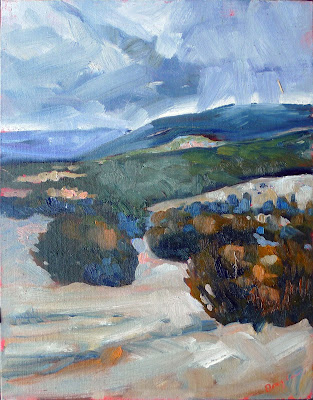I may be the only plein air painter in the world who comes home and says, “I wish I’d simplified less.”
 |
| Late winter along the Pecos River, by Carol L. Douglas |
I know the rules of good design. In my studio, an informal
formal analysis always runs in the back of my mind. I have goals for each painting, and my work is a challenge to meet those goals.
Get me in the field, however, and I enter a sort of fugue state. I paint almost unconsciously. The more difficult the physical challenges, the truer that is.
 |
| Horno in the snow, by Carol L. Douglas |
Fugue state is an old-fashioned term for a rare kind of a
dissociative disorder where the patient forgets who and where they are. I don’t mean to deprecate the sufferings of people with dissociative disorders, which are exceedingly serious. But if the American Psychiatric Association wants to abandon the term, I’m going to adopt it. It perfectly fits my mental state when I’m
plein air painting.
Having painted alongside many, many artists who flail around in anxiety, I think I’m very blessed. I can just cut out the world and think about nothing at all.
 |
| Below the Ridge, by Carol L. Douglas |
A fugue state often involves putting on a whole different identity. That seems to be what happens to me, because my plein air and studio work have very different characters. I may be the only plein air painter in the world who comes home and says, “I wish I’d simplified less.” Everything is mosaic with very little form, and less and less detail as the years go by.
 |
| Snow along the Pecos River, by Carol L. Douglas |
My husband
obliquely challenged that while we were in New Mexico. To challenge myself, I spent one morning in New Mexico staring at pictures of
Peredvizhnikipaintings of log cabins. Then I went out to paint log barns. I think some of that Russian technique permeated the deepest parts of my brain, because I was able to do the log walls with enough detail, without getting fussy. But overall, the painting was pretty similar to everything else I painted that week.
 |
| Upper Reaches of the Pecos River, by Carol L. Douglas |
I can set out to consciously paint a certain way, and it makes no difference. Get me in the woods with my brushes and instinct crowds out all my thinking. Whether that’s good or bad, I don’t know, but it does reflect that I’m happiest outdoors.
Occasionally, readers ask me why I travel to paint—after all, I live in
America’s Vacationland. It’s not the studio that’s the problem, it’s my desk. Sometimes I just want to go away and let the paperwork pile up somewhere I’m not.
 |
| Snow at higher elevations, by Carol L. Douglas |
It’s like a vacation for the brain, except it’s not restful. I work very hard on the road, but mercifully none of it involves marketing. That’s exactly why you should consider a workshop, as well. Mine are
here, if you’re interested.
I got home from New Mexico a week ago today. Yesterday was the first day in which I managed to unpack and photograph my work. Because it has been cold and my paint was thick, most of them were still wet when I left. That necessitated building a more stable carrier system, which I did with an old box, tape and slender strips cut from an old
Coroplast political sign. (
Jane Chapin throws away nothing, bless her heart.)
 |
| Snow below the summit, by Carol L. Douglas |
Interesting, the only one which sustained any damage in transit was in a
PanelPak carrier. A drop of thick white paint migrated on its surface. That had nothing to do with the carrier, and everything to do with how fat the paint was.




